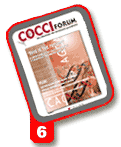Processed vs. Natural vs. Organic: The Final Word
As reported in the last issue of CocciForum (“Natural
Tendencies” CocciForum No. 5), mainstream poultry producers
are increasingly turning to vaccines to produce what consumers
consider more “natural” poultry products.
But what exactly is “natural” and what is not when it comes
to poultry products? Answering that question isn’t as simple as
it might seem.
According to the USDA’s Food Safety and Inspection
Service (FSIS), the term “natural” actually has nothing to do
with the way an animal has been raised; the labeling poses no
prohibitions against the use of drugs or vaccines.
Instead, it specifically addresses the processing procedures
the carcass goes through after the animal has
been slaughtered.
Playing by the rules
The bottom line: The same rules for
drugs and vaccines that apply to all
other chicken products apply to socalled
“natural” chicken as well:
ionophoric anticoccidials (monensin,
lasalocid, salinomycin) are allowed, as are
growth promoters (bacitracin, virginiamycin,
and bambermycin).
If those drugs are used, though, they
must be withdrawn a specified period of
time before slaughtered. If the producer
chooses to make a perceived value-added
claim about the use of drugs — in other
words, “No added antibiotics” — the statement
must include the amount of withdrawal time.
Over the past few years, of course, some
growers have attempted to distinguish themselves
from competitors by touting their birds as having
received no sub-therapeutic levels of anticoccidials and/or
growth promoters. That’s resulted in the increased use of
“negative” labeling claims — “No antibiotics used….”
Just the facts
But the FSIS says that even though many consumers consider
such added claims to be an integral part of the “natural” labeling
requirements, that’s not the case. Again, “natural” refers
only to what happens to the product during processing, in
other words, after slaughter, not before.
As to the added claims — such as “free-range,” “no antibiotics
used,” etc. — FSIS says they can be used as long as they
are backed up by facts. So if the words “No antibiotics used,”
with no qualification, are printed on the label, that means that
the chicken must have received no antibiotics
during its entire life.
Under the “natural” label processing
requirements, meat products must be no more
than “minimally processed.” Roasting, smoking,
freezing, drying, fermenting or meat
grinding are all allowed under the “natural”
labeling requirements. Processes not
allowed under the natural label include
acid hydrolysis, solvent extraction, chemical
bleaching, and mechanical separation
of meat.
Interestingly, the most recent official
USDA directive on this issue is known
as “Policy Memo 055.” It was published
November 22, 1982.
Four organic categories
And what about “organic” foods?
There are more recent changes on
that front. The USDA, just this past October as
the last issue of CocciForum was going to press, published a
new set of national standards for foods labeled “organic.” The
USDA set up four new categories:
• “100% organic;”
• “Organic,” defined by the USDA as containing 95% organic
ingredients;
• “Made with organic,” which includes products with at least
70% organic ingredients;
• Products with less than 70% organic ingredients can’t be
labeled “organic,” and can only list their organic ingredients
in the contents area of their packaging.
Under the current USDA rules, poultry that’s been raised
with the use of in-feed anticoccidials and growth promoters
can’t carry the organic labeling (but, again, can carry the “natural”
labeling, if it’s minimally processed).
Leaning on vaccination
One way that growers are managing to cut down on the use
of drugs in their birds — and thus attract consumers seeking
chicken with less additives — is to lean more heavily on their
use of vaccination, especially vaccination against coccidiosis.
“Over the past 6 years,” says Marcelo Lang of Schering-
Plough Animal Health Corporation, “coccidiosis vaccination
has evolved from being a technique used almost exclusively
by breeder producers and broiler companies targeting specialty
markets, to being a standard practice in today’s mainstream
poultry companies.”
|






 © 2000 - 2021. Global Ag MediaNinguna parte de este sitio puede ser reproducida sin previa autorización.
© 2000 - 2021. Global Ag MediaNinguna parte de este sitio puede ser reproducida sin previa autorización.